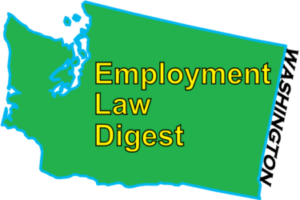This is a case summary of Robel v. Roundup Corporation, 148 Wn.2d 35 (Wash 2002). Subjects include, but are not limited to the following:
» DISABILITY-BASED HOSTILE WORK ENVIRONMENT
» WORKERS’ COMPENSATION ANTI-RETALIATION STATUTE
» INTENTIONAL INFLICTION OF EMOTIONAL DISTRESS
» DEFAMATION
IMPORTANT: This article is for informational purposes only and is based upon my point of view. This is not a resource for the actual and complete appellate court opinion. Due to the rapidly changing nature of the law, we make no warranty or guarantee concerning the accuracy or reliability of the content in this article. No content on this site, regardless of date, should ever be used as a substitute for direct legal advice from your attorney. Please review our Disclaimer|Terms of Use|Privacy Policy before proceeding.

case summarY – 22 Facts:
[1] This suit arises out of Linda Robel’s employment from May 31, 1995, to September 12, 1996, in the service deli at … [the] Fred Meyer store in Spokane.
[2] On July 14, 1996, Robel sustained a workplace injury and timely filed a workers’ compensation claim.
[3] In late July, Robel was given a light-duty assignment, “a four-hour shift” during which she stood “at a display table outside the deli area offering samples of food items to customers.”
[4] On August 1, 1996, as Robel worked at the display table, two deli workers “laughed” and “acted out a slip and fall,” as one of them yelled, “Oh, I hurt my back, L & I, L & I!”
[5] They “audibly called [Robel] a ‘bitc[-]’ and ‘cun[-].'”
[6] They also “told customers she had lied about her back and was being punished by Fred Meyer by ‘demoing’ pizzas.”
[7] In journal entries for August 2, 3, 10, and 11, Robel wrote that assistant deli manager Amy Smith and others made fun of her, laughed, pointed, and gave her “dirty looks.”
[8] Robel also noted that on August 13, Smith and other deli workers would “stare at [her], whisper out loud, & laugh, pretending to hurt their backs & laugh.”
[9] Robel reported the incidents to her union representative, … Banka.
[10] According to Robel’s journal, Banka came in on August 14, 1996, and set up a meeting with … Wissink, the store director, for Friday, August 16.
[11] At [a subsequent all-deli employee meeting, called by Wissink on August 19, 1996,] Wissink warned the employees that future harassment could result in termination.
[12] On August 22, 1996, deli workers “laughed and audibly admonished each other not to harass Robel.”
[13] On August 28 and 30, Robel noted in her journal that co-workers were talking about her and laughing at her, and she recorded that, on September 2, Smith and other workers “had a great time making fun of [her], calling [her] names[,] pretending to hurt their backs & yelling L & I.”
[14] On September 13, 1996, Robel secured a two-week work release from her doctor and gave it to Smith that same day.
[15] Before Robel left the deli, she overheard Smith comment to other deli employees, “Can you believe it, Linda’s gonna sit on her big ass and get paid.”
[16] Robel again contacted [her union rep], who in turn contacted Wissink on September 20, 1996.
[17] On September 24, Wissink telephoned Robel to confirm the allegations. Robel “told him about the C word and Bitc[-][,] the little plays they were doing about [her] back.”
[18] On September 28, 1996, Wissink terminated one employee.
[19] Robel never returned to work at Fred Meyer.
[20] On February 13, 1998, Robel filed suit against Fred Meyer, stating claims for disability discrimination …, retaliation for filing a workers’ compensation claim …, negligent and intentional infliction of emotional distress, and defamation.
[21] The trial court denied Fred Meyer’s motion for summary judgment … [f]inding for Robel on all five causes of action[.]
[22] Fred Meyer appealed. The Court of Appeals reversed the trial court’s judgment on all claims.
Robel v. Roundup Corporation, 148 Wn.2d 35 (Wash 2002) (internal citations omitted) (hyperlink added).
ISSUE #1: Does the Washington Law Against Discrimination, Chapter 49.60 RCW, support an employee’s disability based hostile work environment claim?

[1-1] WASHINGTON LAW AGAINST DISCRIMINATION: Under the Washington Law Against Discrimination (WLAD), RCW 49.60, “It is an unfair practice for any employer to discriminate against any person in compensation or in other terms or conditions of employment because of age, sex, marital status, race, creed, color, national origin, or the presence of any sensory, mental, or physical disability.” Robel v. Roundup Corporation, 148 Wn.2d 35 (Wash 2002) (citing RCW 49.60.180(3)) (alteration to the original).
[1-2] RULES OF CONSTRUCTION: To determine whether the Washington Law Against Discrimination “supports a disability claim based on hostile work environment, [courts] may look to federal cases construing analogous federal statutes.” Id. (citing Fahn v. Cowlitz County, 93 Wash.2d 368, 376, 610 P.2d 857 (1980), 621 P.2d 1293 (1980)).

[1-3] ISSUE OF FIRST IMPRESSION: In this case, the Court determined that whether the Washington Law Against Discrimination supported a disability based hostile work environment was an issue of first impression in the State.
It reasoned that “just as the federal cases extended the Title VII hostile work environment claim (and its standards of proof) to the ADA, we may extend the reasoning in Glasgow to disability claims.” Id. at 45 (hyperlinks added).

[1-4] WLAD SUPPORTS DISABILITY-BASED HOSITLE WORK ENVIRONMENT CLAIMS: The Court held that “the [Washington Law Against Discrimination] … supports a disability based hostile work environment claim.” Id. at 43.
ISSUE #2: Did the trial court’s unchallenged findings of fact support its conclusion of law that Fred Meyer discriminated against Robel based upon her physical disability?

[2-1] DISABILITY BASED HOSTILE WORK ENVIRONMENT: In order to establish a disability based hostile work environment case, a plaintiff must prove “(1) that he or she was disabled within the meaning of the antidiscrimination statute[, WLAD], (2) that the harassment was unwelcome, (3) that it was because of the disability, (4) that it affected the terms and conditions of employment, and (5) that it was imputable to the employer.” Id. at 45.
[2-2] THE SECOND ELEMENT (UNWELCOME): To establish that the harassment was unwelcome, “the plaintiff must show that he or she ‘did not solicit or incite it’ and viewed it as ‘undesirable or offensive.'” Id. (citing Glasgow v. Georgia-Pac. Corp., 103 Wn.2d 401, 406, 693, P.2d 708 (Wash. 1985)).
[2-3] THE THIRD ELEMENT (BECAUSE OF DISABILITY): To establish that the harassment was “because of disability,” requires “[t]hat the disability of the plaintiff-employee be the motivating factor for the unlawful discrimination.” Id. at 46 (citing Glasgow, 103 Wash.2d at 406, 693 P.2d 708)) (alteration to the original). This element requires a nexus between the specific harassing conduct and the particular injury or disability. Id.
[2-4] THE FOURTH ELEMENT (TERMS & CONDITIONS OF EMPLOYMENT): To establish that the harassment affected the terms and conditions of employment, “the harassment must be sufficiently pervasive so as to alter the conditions of employment and create an abusive working environment.” Id. at (citing Glasgow, 103 Wash.2d at 406, 693 P.2d 708)) (alteration to the original).
“[A] satisfactory finding on this element should indicate “that the conduct or language complained of was so offensive or pervasive that it could reasonably be expected to alter the conditions of plaintiff’s employment.'” Id. (citing 6A WASHINGTON PATTERN JURY INSTRUCTIONS: CIVIL 330.23, at 240) (alteration to the original) (hyperlink added).
[2-5] THE FIFTH ELEMENT (IMPUTABLE TO EMPLOYER): To impute harassment to an employer, “the jury must find either that (1) an owner, manager, partner or corporate officer personally participate[d] in the harassment or that (2) the employer … authorized, knew, or should have known of the harassment and failed to take reasonably prompt adequate corrective action.” Id. at 47 (internal citation and quotation marks omitted) (alteration to the original).

[2-6] THE FIRST ELEMENT (DISABLED): In this case, neither party contested that Robel’s injury was a disability under RCW 49.60.180(3). Id. at 35. Therefore, the Court did not further define disabled within the meaning of the antidiscrimination statute. Id.
[2-7] THE SECOND ELEMENT (UNWELCOME): The Court found that no findings suggested that Robel solicited or incited the remarks made about her workplace injury. Id. at 45. That Robel viewed the employer’s conduct as undesirable and offensive was at least implicit in her reporting the conduct to Banka (her Union Representative). Id. at 45-46.
[2-8] THE THIRD ELEMENT (BECAUSE OF DISABILITY): The trial court found that the verbal and non-verbal harassment of Robel in the work setting after July 14, 1996, was directly or proximately related to her disability and/or Fred Meyer’s perception of Robel as disabled. See id. at 46. The Court, in the instant case, elected not to substitute their judgment for that of the trial court. Id.
[2-9] THE FOURTH ELEMENT (TERMS & CONDITIONS OF EMPLOYMENT): The trial court found that Fred Meyer created a hostile and abusive work environment and that the environment was offensive to Robel. Id. at 46-47 (internal quotation marks omitted).
The Court, in the instant case, pointed to an additional trial court finding as follows: “Fred Meyer discriminated against Robel in the terms or conditions of employment when it participated in and/or failed to bring to an end … the verbal and non-verbal harassment of Robel in the work setting.” Id. at 47.
The Court found that this language echoed the “critical language from Glasgow and the pattern jury instruction”; it accepted the findings as “verities” and passed on “any reweighing of the evidence supporting them.” Id.
[2-10] THE FIFTH ELEMENT (IMPUTABLE TO EMPLOYER): The Court identified relevant trial court findings as follows:
[a] “Fred Meyer, through the acts of its managers, participated, authorized, knew and/or should have known of the verbal and non-verbal harassment of Robel in the work setting subsequent to July 14, 1996[;]”
[b] “Fred Meyer’s management personnel improperly participated in and/or allowed the verbal and non-verbal harassment in the work setting[;]”
[c] “deli manager Potts and assistant deli manager Smith were management personnel for purposes of employer liability[;]”
[d] “Fred Meyer’s remedial action … was not of such nature to have been reasonably calculated to end the harassment[;]”
[e] “[Fred Meyer’s] investigations and termination of [one co-worker] without further management corrections were inadequate[;]” and
[f] “the postinjury harassment was ‘imputed to Fred Meyer.'”
Id. at 48 (internal citations and quotation marks omitted) (lettered paragraphs added).
The Court found that these uncontested findings of fact satisfy both options derived from Glasgow. Id.

[2-11] COURT OF APPEALS REVERSED / TRIAL COURT JUDGMENT REINSTATED: The Court concluded “that the Court of Appeals erred when it ignored the trial court’s unchallenged findings of fact on the five essential elements of the claim.” Id. at 48. It then reversed “the Court of Appeals and reinstated the trial court’s judgment in Robel’s favor.” Id.
ISSUE #3: Did the trial court’s unchallenged findings of fact support the conclusion that Fred Meyer, in violation of RCW 51.48.025(1), retaliated against Robel for filing a workers’ compensation claim?

[3-1] WORKERS’ COMPENSATION ANTI-RETALIATION STATUTE: The Washington Industrial Insurance Act “provides that no employer may discharge or in any manner discriminate against any employee because such employee has filed or communicated to the employer an intent to file a claim for compensation or exercises any rights provided under this title.” Id. at 48-49 (citing RCW 51.48.025(1)) (emphasis in original).

[3-2] FRAMING THE ISSUE: In this case, the Court framed the issue essentially as follows: Whether the Workers’ Compensation Anti-Retaliation Statute, RCW 51.48.025(1), applies to an employer “who has allegedly discriminated in some way, short of discharge, against an employee because she filed a workers’ compensation claim[?]” See id. at 50.
[3-3] ELEMENTS OF THE CLAIM: It then found that, “by analogy with Wilmot v. Kaiser Aluminum & Chemical Corp., 118 Wn.2d 46, 68, 821 P.2d 18 (1991), which required proof of a causal connection between the filing of a claim and the allegedly retaliatory termination, Robel was required to prove [1] that she had filed a claim, [2] that Fred Meyer thereafter discriminated against her in some way, and [3] that the claim and the discrimination were causally connected.” Id. at 50.

[3-4] FINDINGS OF FACT SATISFY THE ELEMENTS: The Court held that “because the findings of fact satisfy these elements and were not challenged on appeal, we reverse the Court of Appeals on the retaliation claim and reinstate the trial court’s judgment in Robel’s favor.” Id.
ISSUE #4: Did the Court of Appeals properly hold as a matter of law that Robel’s claim for intentional infliction of emotional distress should not go to the trier of fact?

[4-1] IIED ELEMENTS: To succeed on a claim for outrage–also known as intentional infliction of emotional distress (IIED)–“a plaintiff must prove three elements: (1) extreme and outrageous conduct, (2) intentional or reckless infliction of emotional distress, and (3) severe emotional distress on the part of the plaintiff.” Id. at 51 (internal citations and quotation marks omitted) (emphasis added).
[4-2] QUESTIONS FOR THE JURY: The three elements are fact questions for the jury, and the first element of the test goes to the jury only after the court determines “if reasonable minds could differ on whether the conduct was sufficiently extreme to result in liability.” Id.
[4-3] EXTREME & OUTRAGEOUS CONDUCT: To establish the first IIED element, the plaintiff must prove “that the conduct was so outrageous in character, and so extreme in degree, as to go beyond all possible bounds of decency, and to be regarded as atrocious, and utterly intolerable in a civilized community.” Id. (citing Dicomes v. State, 113 Wn.2d 612, 630, 782 P.2d 1002 (1989)) (internal quotation marks omitted).
[4-4] RELATIONSHIP BETWEEN PARTIES (IIED): In an outrage claim “[t]he relationship between the parties is a significant factor in determining whether liability should be imposed.” Id. at 52 (citing Contreras v. Crown Zellerback Corp., 88 Wn.2d 735, 741, 565 P.2d 1173 (1977)).
“The Contreras court emphasized that ‘added impetus’ is given to an outrage claim ‘[w]hen one in a position of authority, actual or apparent, over another has allegedly made racial slurs and jokes and comments.” Robel, 148 Wn.2d at 52 (citing Contreras, 88 Wn.2d 735, 741, 565 P.2d 1173 (1977); see also White v. Monsanto Co., 585 So.2d 1205, 1210 (La. 1991) (stating that “plaintiff’s status as an employee may entitle him to a greater degree of protection from insult and outrage by a supervisor with authority over him than if her were a stranger”)).
[4-5] VICARIOUS LIABILITY: “Once an employee’s underlying tort is established, the employer will be held vicariously liable if ‘the employee was acting within the scope of his employment.'” Id. at 53 (citing Dickinson v. Edwards, 105 Wn.2d 457, 469, 716 P.2d 814 (1986)).
“An employer can defeat a claim of vicarious liability by showing that the employee’s conduct was (1) ‘intentional or criminal’ and (2) ‘outside the scope of employment.'” Id. (citing Niece v. Elmview Group Home, 131 Wn.2d 39, 56, 929 P.2d 420 (1997) (emphasis in original), quoted with approval in Snyder v. Med. Servs. Corp. of E. Wash., 145 Wn.2d 233, 242-43, 35 P.3d 1158 (2001)).
[4-6] SCOPE OF EMPLOYMENT: “An employee’s conduct will be outside the scope of employment if it “is different in kind from that authorized, far beyond the authorized time or space limits, or too little actuated by a purpose to serve the master.'” Id. (citing RESTATEMENT (SECOND) OF AGENCY § 228(2) (1958); see also RESTATEMENT, supra, § 228(1)).

[4-7] FIRST ELEMENT (EXTREME & OUTRAGEOUS CONDUCT): “Robel was called in her workplace names so vulgar that they have acquired nicknames, such as ‘the C word,’ for example.” Id. at 52. (internal citation omitted) (emphasis in original).
[4-8] VICARIOUS LIABILITY: “Fred Meyer deli workers tormented Robel on company property during working hours, as they interacted with co-workers and customers and performed the duties they were hired to perform. Nothing in the record suggests that the abusive employees left their job stations or neglected their assigned duties to launch the verbal attacks on Robel.” Id. at 54.

[4-9] REASONABLE MINDS COULD CONCLUDE EXTREME AND OUTRAGEOUS CONDUCT: On the threshold question (extreme and outrageous conduct) the Court concluded that reasonable minds could conclude that, in light of the severity and context of the conduct, it was beyond all possible bounds of decency, atrocious, and utterly intolerable in a civilized community. See id. at 51-52.
[4-10] FRED MEYER VICARIOUSLY LIABLE: The Court also concluded that Fred Meyer was vicariously liable, “that reasonable minds could find the complained-of conduct outrageous, and that the uncontested findings satisfied the three elements of outrage.” Id. at 54-55.
[4-11] COURT OF APPEALS REVERSED / REINSTATED TRIAL COURT’S JUDGMENT FOR ROBEL ON IIED: The Court then reversed the Court of Appeals and reinstated the trial court’s judgment for Robel on her claim for intentional infliction of emotional distress. Id. at 55. Because Robel was successful on this claim, the Court found it unnecessary to consider Robel’s companion claim for negligent infliction of emotional distress. Id.
ISSUE #5: Were the allegedly defamatory communications cited in the trial court’s findings capable of defamatory meaning?

[5-1] DEFAMATION: A defamation plaintiff must prove the following four essential elements: (1) falsity, (2) an unprivileged communication, (3) fault, and (4) damages. Id. at 55 (citing Mark v. Seattle Times, 96 Wn.2d 473, 486, 635 P.2d 1081 (1981), cert. denied, 457 U.S. 1124, 102 S.Ct. 2942, 73 L.Ed. 2d 1339 (1982)) (emphasis added).
[5-2] FALSITY: “Before the truth or falsity of an allegedly defamatory statement can be assessed, a plaintiff must prove that the words constituted a statement of fact, not an opinion. Because expressions of opinion are protected under the First Amendment, they are not actionable.” Id. (citing Camer v. Seattle Post-Intelligencer, 45 Wn.App. 29, 39, 723 P.2d 1195 (1986) (internal quotation marks and citations omitted) (emphasis added).
“Whether the allegedly defamatory words were intended as a statement of fact or an expression of opinion is a threshold question of law for the court.” Id. (internal citations omitted).
[5-3] TOTALITY OF THE CIRCUMSTANCES: To determine whether words should be viewed as nonactionable opinions, the court considers the totality of the circumstances surrounding those statements. Id. at 56.
[5-4] DUNLAP 3-FACTOR TEST: To determine whether a statement is nonactionable, a court should consider at least (1) the medium and context in which the statement was published, (2) the audience to whom it was published, and (3) whether the statement implies undisclosed facts.” Id. (citing Dunlap v. Wayne, 105 Wn.2d 529, 539, 716 P.2d 842 (1986)).

[5-5] THE VULGARISMS (I.E., “BITC-,” “CUN-,” “FUC-ING BITC-,” “FUC-ING CUN-“) ALONG WITH THE WORD “IDIOT”: The Court concluded that these vulgarisms along with the word “idiot” were plainly abusive words, but they were not intended to be taken literally as statements of fact. Id. Thus, they did not pass the threshold question of law.
[5-6] THE WORDS “SNITCH,” “SQUEALER,” AND “LIAR”: The Court considered the totality of the circumstances and applied the Dunlap Three-Factor Test. It held as a matter of law that these words also constituted nonactionable opinions. Id. at 56.
Regarding the first Dunlap Factor (Medium & Context): the Court found that the oral statements were made in circumstances and places that invited exaggeration and personal opinion. Id.
Regarding the second Dunlap Factor (The Audience): the Court found that the employee audience (i.e., Fred Meyer co-workers and management personnel) was “prepared for mischaracterization and exaggeration” and would have registered the words, if at all, “as expressions of personal opinion, not as statements of fact.” Id. at 57. And customers hearing the words “would reasonably perceive that the speaker was an antagonistic or resentful co-worker.” Id.
Regarding the third Dunlap Factor (Whether the Words Implied Undisclosed Defamatory Facts): deli workers would have known the facts ostensibly underlying the words, and the words disclosed to customers (i.e., “that Robel was demoing pizzas because she had lied about her back”) “implies no undisclosed defamatory facts.” Id. (internal quotation marks omitted).

[5-7] ALL OF THE UTTERANCES WERE NONACTIONABLE OPINIONS: The Court concluded that all of the utterances were nonactionable opinions and reaffirmed the reversal of the trial court’s judgment on Robel’s defamation claim. Id.
NOTABLES & IMPLICATIONS:
DISABILITY
(1) This case adds an additional initial element to the hostile work environment rule for cases based on disability: He or she must be disabled within the meaning of the Washington Law Against Discrimination.
INTENTIONAL INFLICTION OF EMOTIONAL DISTRESS (IIED)
(2) The standard for an outrage claim is very high (meaning that the conduct supporting the claim must be appallingly low). See id. at 51.
(3) Relationship Between Parties. In an outrage claim, “[t]he relationship between the parties is a significant factor in determining whether liability should be imposed.” Id. at 52 (citing Contreras v. Crown Zellerback Corp., 88 Wn.2d 735, 741, 565 P.2d 1173 (1977)).
“The Contreras court emphasized that ‘added impetus’ is given to an outrage claim ‘[w]hen one in a position of authority, actual or apparent, over another has allegedly made racial slurs and jokes and comments.” Id. (citing Contreras, 88 Wn.2d 735, 741, 565 P.2d 1173 (1977); see also White v. Monsanto Co., 585 So.2d 1205, 1210 (La. 1991) (stating that “plaintiff’s status as an employee may entitle him to a greater degree of protection from insult and outrage by a supervisor with authority over him than if her were a stranger”)).
PERSONAL JOURNALS / DIARIES
(4) In Washington State, an employee’s personal journal entries regarding discrimination at work might be allowed by the court to support a claim of unlawful employment discrimination. See, e.g., id. at 41.
SEXUAL HARASSMENT
(5) Washington Law Against Discrimination prohibits sexual harassment in employment, with such claims being generally categorized as quid pro quo harassment claims or hostile work environment claims. See id. at 43 (citing DeWater v. State, 130 Wn.2d 128, 134-35, 921 P.2d 1059 (1996)) (internal citations and quotation marks omitted).
TITLE VII & WLAD
(6) “The [Washington Law Against Discrimination,] … which applies with equal force to sex based and disability based employment discrimination, is analogous to Title VII and the ADA.” Id. at 44.
(7) Although federal cases interpreting Title VII are not binding on the Court, they are instructive and supportive. See id. at 44.
VICARIOUS LIABILITY
(8) Intentional or criminal conduct is not per se outside the cope of employment. Id. at 53.
(9) It is not the case that an employer will be vicariously liable only where it has specifically authorized an employee to act in an intentionally harmful or negligent manner. See id.
(10) An employer may not insulate itself from vicarious liability merely by adopting a general policy proscribing bad behavior that would otherwise be actionable. Id.
(11) The proper vicarious liability inquiry is whether the employee was fulfilling his or her job functions at the time he or she engaged in the injurious conduct. See id.
(12) When a servant steps aside from the master’s business in order to effect some purpose of his own, the master is not liable. Id. at 54 (citing Kuehn v. White, 24 Wn.App. 274, 277, 600 P.2d 679 (1979)) (internal quotation marks omitted).
(13) Where an employee’s acts are directed toward personal sexual gratification, the employee’s conduct falls outside the scope of his or her employment. See id.
WORKERS’ COMPENSATION ANTI-RETALIATION STATUTE
(14) To establish a claim of unlawful workers’ compensation retaliation, a plaintiff must prove (1) that the plaintiff filed a claim, (2) that the employer thereafter discriminated against the plaintiff is some way, and (3) that the claim and the discrimination were causally connected. See id. at 50.
LEARN MORE
If you would like to learn more, consider contacting an experienced employment discrimination attorney to discuss your case. This article is not offered as legal advice and will not establish an attorney-client relationship with Washington Employment Law Digest or the author of this article. By reading this article, you agree to our Disclaimer / Terms-of-Use / Privacy Policy.




